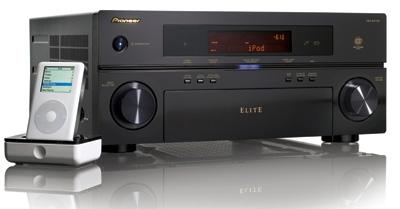Pioneer Elite VSX-94TXH A/V Receiver

Feature creatures, take note: If you like tweaking, selecting, optimizing, and customizing, read on. Personally, I'm usually not big on extras. But the VSX-94TXH, Pioneer's latest high-range A/V receiver in the company's Elite line, boasts an options list with enough unusual, interesting, and downright useful functions that I'm climbing down off my high horse for a bit.
Importantly, the basics are well represented, too: full-function HDMI 1.3a inputs (four of 'em) with Faroudja DCDi upscaling, video cross-conversion from lesser formats to HDMI output, 7 x 140 watts of rated power, THX Select 2 certification, onboard decoding of Dolby TrueHD and DTS-HD Master Audio (given a compatible player, of course), and auto-setup and calibration with included mike. And these are still the basics.
Setup Physical setup imposed no special demands. I connected my 6.1-channel speaker array and hooked up Blu-ray Disc/DVD, SACD, and HD-cable sources via HDMI, component, and multichannel-analog means. I already have a network cable from my router to my rack, which I connected to the Pioneer's Ethernet jack for its Home Media Gallery streaming functions. My Comcast cable box provided the perfect opportunity to try out the receiver's analog-to-HDMI conversion and upscaling. Both proved excellent.
Next, with the Pioneer's calibration mike at my usual listening position, I fired up its MCACC (Multi-Channel Acoustic Calibration Control) automation. The full routine of noise bursts took about 5 minutes, and it yielded quite accurate channel levels and crossover settings for my setup. MCACC also includes two different auto-EQ routines, one for speaker/room-correction, which Pioneer dubs "Acoustic Cal EQ," and one for "Standing Wave," which attempts to mitigate low-frequency room anomalies.
Then there's what Pioneer calls "Full-Band Phase Control," which purports to "minimize group delay between the middle- and low-frequency ranges," promising, among other benefits, "better surround integration for multichannel sources." As best as I could determine, the process attempts to time-align the speakers to compensate for the "late" arrivals of sound from the woofers and the midranges, which originates from further back than the sound from a tweeter. (I should mention in passing that some eminent speaker designers and analysts disagree energetically about the fundamental need for such correction or compensatory design.) I'm not quite sure how the Pioneer (or any similar system) could "know" if the midrange (for example) from a given speaker arrived directly or if the mike was instead "hearing" a reflection, with its consequently longer path length. Suffice to say, it's a slippery subject.
Nonetheless, I was generally happy with the Pioneer's results in the amplitude and frequency domains. Its auto-EQ routines are quite sophisticated, though the user interface is a bit obscure, particularly if you elect the "Professional" option. This allows you to adjust the "time window" for analysis, thereby limiting corrections more to direct, first-arrival sounds or opening its calculations to include more reflected sounds (and thus room effects). Complicated, for sure - but most users will likely not sweat it and just let the receiver do its thing.
But there's more: You can also connect the receiver's serial port to your PC and use a Windows program downloadable from Pioneer to achieve still finer control and to generate graphs of the data collected by MCACC. Time prevented me from fully exploring all of that, but it looks pretty cool. If your inner geek takes you there, have a ball.
The Pioneer converts incoming analog video - composite, S-, or component - each up to the "higher" formats and to HDMI. The resultant digital output can be set to either "Auto" or "Pure," as well as to various resolutions. Auto mode will automatically detect the native resolution on most HDMI displays and set the receiver accordingly; this will yield 1080i or 720p conversion, in most cases. The Pure mode preserves incoming resolution and simply converts to digital for output via HDMI. Or the receiver can be set to scale everything to 480/576p, 720p, 1080i, or 1080p - though 1080p output works only on 480i/p or 576i/p signals. But I was puzzled to find Pioneer relegates any mention of these settings to the back of the manual, under "Using Other Functions." I was also puzzled by the fact that, oddly, they're not accessed via the onscreen menus, but only on the small front-panel display.
Performance Well, I've exhausted enough of my column-inches already, so let's get to the truly important stuff. The VSX-94TXH had ample power to drive my quite high-end speaker suite to cinematic levels and well beyond in my studio of 2,500-plus cubic feet - and it sounded just fine in doing so. I wasn't crazy about the effect of the MCACC equalizations, but these are defeatable and manually modifiable, so no worries. Anyway, every room/loudspeaker setup - or, if experience is any guide, the same setup when it's rerun with the mike moved a few inches - will induce very different results, so this has precisely zero predictive value upon your experience.
The Full Band Phase control definitely did something, changing the "texture" of some elements and the overall spatial sense of both stereo and surround. But I'm not ready to say it was "better" (or, necessarily, "worse") in either sense; I'd need a lot more time, and controlled listening, to make any value judgment here. Being largely a purist at heart, I mostly left this control disengaged - but by all means, give it a listen.





























































